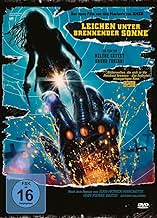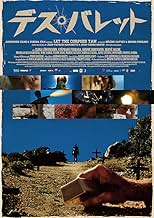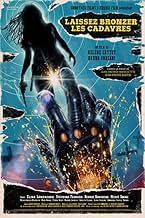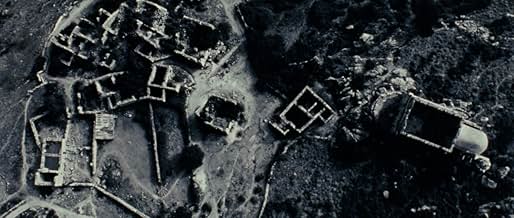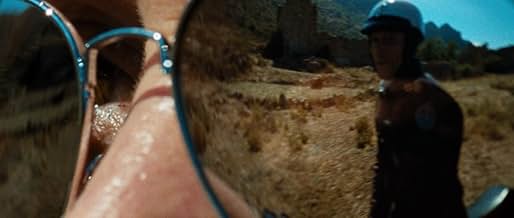AVALIAÇÃO DA IMDb
6,2/10
3,7 mil
SUA AVALIAÇÃO
Adicionar um enredo no seu idiomaA grizzled thug and his gang head to an island retreat with a haul of 250 kilograms of gold bullion to lay low; however, a bohemian writer, his muse, and a pair of gendarmes further complica... Ler tudoA grizzled thug and his gang head to an island retreat with a haul of 250 kilograms of gold bullion to lay low; however, a bohemian writer, his muse, and a pair of gendarmes further complicate things, as allegiances are put to the test.A grizzled thug and his gang head to an island retreat with a haul of 250 kilograms of gold bullion to lay low; however, a bohemian writer, his muse, and a pair of gendarmes further complicate things, as allegiances are put to the test.
- Direção
- Roteiristas
- Artistas
- Prêmios
- 4 vitórias e 9 indicações no total
Marilyn Jess
- La policière
- (as Dominique Troyes)
Avaliações em destaque
LET THE CORPSES TAN (LAISSEZ BRONZER LES CADAVRES!): A pretty good shootout thriller which is a bit messed up by philosophical and avant garde pretensions in fantasy sequences (some may be memories) and stilted dialogue. They don't quite negate the negation but might have negated the the film. Fortunately the action shots triumph over the postmodernist pisstakes to acheive a satisfactory synthesis.
An artist and a novelist are living in a series of ruins on a hilltop in the South of France, their lawyer arrives but has made a pact with a gang of Gold Bullion robbers to use the abode as a hideout. Meanwhile the author's wife arrives with her maid and a child (snatched) from a previous realtionship. Actually the robbers meet them by the hitching and give them a lift. Motorcycle cops investigating both the robbery and child abduction come to the ruins.
A many sided battle ensues with shifting allegiances taking place. This is very much a homage to/pastiche of the exploitation euro-Gangster films of the 1970's but is weakened by (imho) unnecessary psychedelic additions. The only effects I really appreciated was the effect of the Gold on the crooks, their faces tanned with avarice as they gazed on the bullion. Reminiscent of scenes from The Treasure Of The Sierra Madre. Some really savage and bloody scenes.
Directors Hélène Cattet and Bruno Forzani with the assistance of novelist Jean-Pierre Bastid on the screenplay would have delivered a pretty good thriller if they'd left out or toned down the biarrare elements. 6.5/10
An artist and a novelist are living in a series of ruins on a hilltop in the South of France, their lawyer arrives but has made a pact with a gang of Gold Bullion robbers to use the abode as a hideout. Meanwhile the author's wife arrives with her maid and a child (snatched) from a previous realtionship. Actually the robbers meet them by the hitching and give them a lift. Motorcycle cops investigating both the robbery and child abduction come to the ruins.
A many sided battle ensues with shifting allegiances taking place. This is very much a homage to/pastiche of the exploitation euro-Gangster films of the 1970's but is weakened by (imho) unnecessary psychedelic additions. The only effects I really appreciated was the effect of the Gold on the crooks, their faces tanned with avarice as they gazed on the bullion. Reminiscent of scenes from The Treasure Of The Sierra Madre. Some really savage and bloody scenes.
Directors Hélène Cattet and Bruno Forzani with the assistance of novelist Jean-Pierre Bastid on the screenplay would have delivered a pretty good thriller if they'd left out or toned down the biarrare elements. 6.5/10
Well, here's one issue we can discern right away: this film is blithely imitative. Nods or homages are one matter, but without a supple, delicate hand to guide the intention, any passing familiarity to other works or filmmakers is blunt and heavy-handed to the point of irritation. Not even ten minutes have passed and I see Ennio Morricone, Sergio Leone, Quentin Tarantino, David Fincher, Jay Rabinowitz, and more, recalled with a forcefulness that's distinctly off-putting. That forcefulness readily applies or extends to the direction, cinematography, editing, sound design, dialogue, acting, music, and effects, and arguably even to the production design, costume design, hair, and makeup. This isn't to say that 'Laissez bronzer les cadavres,' or 'Let the corpses tan,' can't still be enjoyable and worthwhile, but it's not an encouraging start, and the brusqueness, gawkiness, and flat-out aggressiveness of the project continues to be emphatically bothersome.
True, the filming locations are gorgeous. I do like the music selections themselves; would that the audio weren't so imbalanced, with the music egregiously high in the mix. Most bits and pieces here are just fine in and of themselves, in fact - or at least they are on paper, and would be in practice if they were approached with even the slightest sense of tact or nuance. Yet whether one wishes to attribute the tiresome zealousness of the presentation to filmmakers Hélène Cattet and Bruno Forzani alone, or also lay some responsibility on the shoulders of all other contributors, as we see it the picture is so impetuous and severe in its fundamental construction that it becomes taxing. By the time only one-third of the length has elapsed it feels like we've been watching for much longer. What it comes down to is this: there is earnest substance in 'Laissez bronzer les cadavres' as a violent thriller, but that substance is distinctly overwhelmed and almost entirely subsumed by the prioritization of Style, Style, Style. You've heard of "Location, Location, Location?" Well, here we are.
There's actually a lot to like here. Consider the root idea by itself, and we have a compelling, hard-charging action-crime flick on our hands, even if the discrete course of events is at most a tertiary concern. I recognize the skill and intelligence that shaped this feature, and that was poured into every component part. There are terrific ideas here, in pretty much every regard. I sharply disagree with the choices of how this was put together, however, including far too many embellishments that are supposed to lend flavor but which instead just come off as self-indulgent excess, especially in light of the general ethos behind the craftsmanship. I suppose it's also worth mentioning that the movie isn't very good at introducing or identifying characters, though in fairness this facet hardly matters; the violence, murder, and betrayal are clear enough without elucidation in the script of who is who, or where exactly their allegiances lie. More troubling is that some narrative elements go completely unexplained as they present; who is "the golden woman?" Beats me.
Factor in frenetic pacing in the direction and deliberately disjointed sequencing, and the unfortunate result is that the genuine value that 'Laissez bronzer les cadavres' has to offer is at best equaled and at worst far outweighed and dampened by Cattet and Forzani's extreme favor of flashy zest and flair over function, let alone mindfulness. There really is a lot that's done well here, but the sad truth is that the filmmakers' impulses needed to be significantly reined in, and the entertainment is not only reduced by the underlying slant but also specifically takes hits from those ways in which the presentation is heedlessly overdone. I assume that the novel this is based on is more lucid; I certainly hope so, at least, for the sake of Jean-Patrick Manchette and Jean-Pierre Bastid. One way or another, the fate of this 2017 picture is sealed. By all means, I'm glad for those who get more out of this and think it's a really great time, but I'm much less than fully convinced. For what it's worth, I look forward to checking out more from all involved, if only out of curiosity, yet 'Laissez bronzer les cadavres' itself is best reserved for a niche audience of which I am not part.
True, the filming locations are gorgeous. I do like the music selections themselves; would that the audio weren't so imbalanced, with the music egregiously high in the mix. Most bits and pieces here are just fine in and of themselves, in fact - or at least they are on paper, and would be in practice if they were approached with even the slightest sense of tact or nuance. Yet whether one wishes to attribute the tiresome zealousness of the presentation to filmmakers Hélène Cattet and Bruno Forzani alone, or also lay some responsibility on the shoulders of all other contributors, as we see it the picture is so impetuous and severe in its fundamental construction that it becomes taxing. By the time only one-third of the length has elapsed it feels like we've been watching for much longer. What it comes down to is this: there is earnest substance in 'Laissez bronzer les cadavres' as a violent thriller, but that substance is distinctly overwhelmed and almost entirely subsumed by the prioritization of Style, Style, Style. You've heard of "Location, Location, Location?" Well, here we are.
There's actually a lot to like here. Consider the root idea by itself, and we have a compelling, hard-charging action-crime flick on our hands, even if the discrete course of events is at most a tertiary concern. I recognize the skill and intelligence that shaped this feature, and that was poured into every component part. There are terrific ideas here, in pretty much every regard. I sharply disagree with the choices of how this was put together, however, including far too many embellishments that are supposed to lend flavor but which instead just come off as self-indulgent excess, especially in light of the general ethos behind the craftsmanship. I suppose it's also worth mentioning that the movie isn't very good at introducing or identifying characters, though in fairness this facet hardly matters; the violence, murder, and betrayal are clear enough without elucidation in the script of who is who, or where exactly their allegiances lie. More troubling is that some narrative elements go completely unexplained as they present; who is "the golden woman?" Beats me.
Factor in frenetic pacing in the direction and deliberately disjointed sequencing, and the unfortunate result is that the genuine value that 'Laissez bronzer les cadavres' has to offer is at best equaled and at worst far outweighed and dampened by Cattet and Forzani's extreme favor of flashy zest and flair over function, let alone mindfulness. There really is a lot that's done well here, but the sad truth is that the filmmakers' impulses needed to be significantly reined in, and the entertainment is not only reduced by the underlying slant but also specifically takes hits from those ways in which the presentation is heedlessly overdone. I assume that the novel this is based on is more lucid; I certainly hope so, at least, for the sake of Jean-Patrick Manchette and Jean-Pierre Bastid. One way or another, the fate of this 2017 picture is sealed. By all means, I'm glad for those who get more out of this and think it's a really great time, but I'm much less than fully convinced. For what it's worth, I look forward to checking out more from all involved, if only out of curiosity, yet 'Laissez bronzer les cadavres' itself is best reserved for a niche audience of which I am not part.
The people who are giving this really bad reviews must be knuckle draggers. This is a very unique and interesting flawed thriller. Flawed because is a little hard to follow with all the time jumps and inserted symbolism.
But if you stick with it you should be rewarded with a very interesting layered movie like you have not seen in a long long while.
It's a thinking man's (or woman's) movie. Pay attention.
But if you stick with it you should be rewarded with a very interesting layered movie like you have not seen in a long long while.
It's a thinking man's (or woman's) movie. Pay attention.
Dang. Can we get some more arthouse action movies like this, please? This movie was a freaking blast.
"Let the Corpses Tan" is a highly stylized neo-spaghetti western (complete with a Morricone score!), and for all I know it's a pioneer in it's genre, because I've never seen anything like this: it's exciting, sometimes intense, and undeniably weird. To be fair, the weirdness in this movie works wonders up to a point, but there are other moments where I had no idea what the hell was going on, because (dare I say it, and risk angering the cinephiles?) the film was a bit too stylized at times, particularly when it came to the frenetically paced editing during the shootouts, and the rapid back and forth flitting between time. Still, if you've got a smidge of patience and a bit of imagination, you can totally understand what the directors are getting at, even if they are showing the audience a fully nude woman whose been painted gold and is peeing on a man's head whose been buried up to his neck.
It makes sense, trust me; you've just got to work with the movie.
"Let the Corpses Tan" is a highly stylized neo-spaghetti western (complete with a Morricone score!), and for all I know it's a pioneer in it's genre, because I've never seen anything like this: it's exciting, sometimes intense, and undeniably weird. To be fair, the weirdness in this movie works wonders up to a point, but there are other moments where I had no idea what the hell was going on, because (dare I say it, and risk angering the cinephiles?) the film was a bit too stylized at times, particularly when it came to the frenetically paced editing during the shootouts, and the rapid back and forth flitting between time. Still, if you've got a smidge of patience and a bit of imagination, you can totally understand what the directors are getting at, even if they are showing the audience a fully nude woman whose been painted gold and is peeing on a man's head whose been buried up to his neck.
It makes sense, trust me; you've just got to work with the movie.
The concept is simple: a gang of criminals stay at the isolated hideaway of an eccentric artist and her lover after stealing 250 kilos of gold. Shenanigans ensue. And they ensue quite strangely.
This is a psychosexual surrealist film disguised as a spaghetti western. Many are judging this strictly in its capacity as a spaghetti western, claiming that the strange, surreal scenes were merely a waste of time. If anything, the opposite is true. The power dynamics, back-stabbing, and fights for survival are secondary to this film's main goal, which seems to be as follows: to show (as stylishly and creatively as possible) these characters' darkest impulses and fantasies. Very similar to their last work, The Strange Color of Your Body's Tears, Hélène Cattet and Bruno Forzani place equal importance upon what's going on in the "reality" of the film and what's going on inside the characters' heads. One character's overwhelming and confounding sexual fantasy might be given just as much dramatic weight and screen-time as another character shifting their allegiance or being killed, despite the fact that one of these scenes makes sense in the context of the plot and the other does not. This feels less like watching a spaghetti western than it does like watching a nightmarish wet dream of someone who had seen a spaghetti western the night before.
The nature of this film makes it difficult to give it a rating. The mish-mosh of high-brow and low-brow elements makes it very hard to compare to any other films. Yes, people always compare this directing duo to Argento, but their obsessive need to explore the subconscious fantasies of their characters is vastly different than any of Argento's work. Their films take place maybe 80% in the characters' heads whereas Argento's films usually take place firmly in reality (albeit, a strange, uniquely lit reality). All in all, I would give it an 8/10, and that rating is hard-earned through ingenuity alone. The characters can barely be called archetypes, there's no one to sympathize with, you barely know anything about any of the characters save for the most banal backstories, the plot isn't given much attention, and there seem to be major moments that are oddly glossed over. Instead of focusing on all these elements that would make a movie "good" in a traditional sense, Cattet and Forzani dive deep into a sexual dreamland of violence and fantasy and do so with constant and I mean CONSTANT creativity.
Almost every single scene is filmed in a way that feels enchantingly fresh. Since it pulls heavily from the spaghetti western genre (a genre that I adore, but has been done into the ground, then spoofed into the ground, then tributed into the ground), there are scene types that we've all watched a thousand times before. Predictable moments that you'd expect to be filmed in a cookie cutter fashion. Instead, each scene is treated like a feverish, experimental short film designed to get the general gist of plot details across, but, much more importantly, utterly enrapture its audience with shockingly gorgeous cinematography, mind-bending editing, and sound design that will have you weeping with joy, all to communicate a sense of otherworldly, darkly violent sexual tension. Admittedly, for every experimental scene that works, there's one that doesn't, but because of the sheer quantity of risks this film is willing to take, the missteps are more than forgivable. I found myself thinking of Hausu while watching it, another film where at one moment I would say to myself, "Why would they film it like this...?" and in the next, "I don't know. But I love it." This is the result of two filmmakers having unabashed fun with their medium and I personally found their subversive glee to be infectious. If you want to see a traditional, Oscar-ready thriller...avoid this one. But if you want to see a whacky fun-house of experimental style, go get your ticket now.
This is a psychosexual surrealist film disguised as a spaghetti western. Many are judging this strictly in its capacity as a spaghetti western, claiming that the strange, surreal scenes were merely a waste of time. If anything, the opposite is true. The power dynamics, back-stabbing, and fights for survival are secondary to this film's main goal, which seems to be as follows: to show (as stylishly and creatively as possible) these characters' darkest impulses and fantasies. Very similar to their last work, The Strange Color of Your Body's Tears, Hélène Cattet and Bruno Forzani place equal importance upon what's going on in the "reality" of the film and what's going on inside the characters' heads. One character's overwhelming and confounding sexual fantasy might be given just as much dramatic weight and screen-time as another character shifting their allegiance or being killed, despite the fact that one of these scenes makes sense in the context of the plot and the other does not. This feels less like watching a spaghetti western than it does like watching a nightmarish wet dream of someone who had seen a spaghetti western the night before.
The nature of this film makes it difficult to give it a rating. The mish-mosh of high-brow and low-brow elements makes it very hard to compare to any other films. Yes, people always compare this directing duo to Argento, but their obsessive need to explore the subconscious fantasies of their characters is vastly different than any of Argento's work. Their films take place maybe 80% in the characters' heads whereas Argento's films usually take place firmly in reality (albeit, a strange, uniquely lit reality). All in all, I would give it an 8/10, and that rating is hard-earned through ingenuity alone. The characters can barely be called archetypes, there's no one to sympathize with, you barely know anything about any of the characters save for the most banal backstories, the plot isn't given much attention, and there seem to be major moments that are oddly glossed over. Instead of focusing on all these elements that would make a movie "good" in a traditional sense, Cattet and Forzani dive deep into a sexual dreamland of violence and fantasy and do so with constant and I mean CONSTANT creativity.
Almost every single scene is filmed in a way that feels enchantingly fresh. Since it pulls heavily from the spaghetti western genre (a genre that I adore, but has been done into the ground, then spoofed into the ground, then tributed into the ground), there are scene types that we've all watched a thousand times before. Predictable moments that you'd expect to be filmed in a cookie cutter fashion. Instead, each scene is treated like a feverish, experimental short film designed to get the general gist of plot details across, but, much more importantly, utterly enrapture its audience with shockingly gorgeous cinematography, mind-bending editing, and sound design that will have you weeping with joy, all to communicate a sense of otherworldly, darkly violent sexual tension. Admittedly, for every experimental scene that works, there's one that doesn't, but because of the sheer quantity of risks this film is willing to take, the missteps are more than forgivable. I found myself thinking of Hausu while watching it, another film where at one moment I would say to myself, "Why would they film it like this...?" and in the next, "I don't know. But I love it." This is the result of two filmmakers having unabashed fun with their medium and I personally found their subversive glee to be infectious. If you want to see a traditional, Oscar-ready thriller...avoid this one. But if you want to see a whacky fun-house of experimental style, go get your ticket now.
Você sabia?
- CuriosidadesDario Argento's Deep Red (1975) famous soundtrack is used.
- ConexõesReferences Quando os Brutos se Defrontam (1967)
Principais escolhas
Faça login para avaliar e ver a lista de recomendações personalizadas
- How long is Let the Corpses Tan?Fornecido pela Alexa
Detalhes
Bilheteria
- Faturamento bruto nos EUA e Canadá
- US$ 93.409
- Fim de semana de estreia nos EUA e Canadá
- US$ 11.918
- 2 de set. de 2018
- Faturamento bruto mundial
- US$ 93.409
- Tempo de duração1 hora 32 minutos
- Cor
- Proporção
- 2.35 : 1
Contribua para esta página
Sugerir uma alteração ou adicionar conteúdo ausente

Principal brecha
What is the Spanish language plot outline for Laissez bronzer les cadavres (2017)?
Responda



